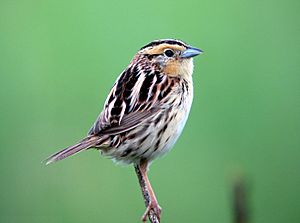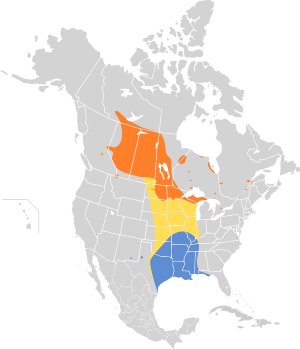LeConte's sparrow facts for kids
Quick facts for kids LeConte's sparrow |
|
|---|---|
 |
|
| Conservation status | |
| Scientific classification | |
| Genus: |
Ammospiza
|
| Species: |
leconteii
|
 |
|
LeConte's sparrow (Ammospiza leconteii) is one of the smallest New World sparrow species in North America.
It is a very secretive bird that prefers to spend most of its time on the ground under the cover of tall grasses. They are typically very difficult to flush, often only flushing at a distance of 1–3 m as they prefer to run across the ground. When they do emerge they rarely fly more than a foot or two above the grass and often descend again within a few meters. Because it is so rarely seen, there are still many gaps in knowledge about the LeConte's sparrow. Nests are often very hard to find, and individuals are more often identified by sound than by sight.
Contents
Description
LeConte's sparrow is a small sparrow with a relatively large head, short grey bill and short pointed tail. It has a buffy yellow-orange face with grey cheeks, and a dark brown crown with a white central stripe. The nape of the neck is lilac grey with chestnut streaks, and the back is streaked with brown and beige. Its belly is off white, while the breast and sides are a buffy orange-yellow with dark brown streaks. The feet and legs are a brownish-pink colour.
Measurements
The measurements for both sexes are:
- Length: 4.7 in/ 12 cm
- Wingspan: 7.1 in/18 cm
- Weight: 0.4-0.6 oz/ 12-16 g
Similar birds
LeConte's sparrow is commonly mistaken for:
There has been a recorded case of a LeConte's sparrow hybridized with a Nelson's sparrow, in June 1949 in Ontario.
Taxonomy
LeConte's sparrow is a member of the order Passerifomes, which are the perching birds, sometimes less accurately referred to as the songbirds. It is from the family Passerellidae, which is characterized by species of small birds with bills adapted to seed eating. LeConte's sparrow was placed in the genus Ammodramus in the past and a molecular phylogeny of the related groups identified that genus as being polyphyletic and recommended the group to be split up. This species falls within the genus Ammospiza clade which includes A. maritimus, A. nelsoni, and A. caudacutus, which are the ground-loving sparrows that prefer staying in tall, thick grasses to perching on trees.
The LeConte's sparrow was discovered by John James Audubon, and it was thought that he named this bird after a friend, Doctor LeConte. It is generally believed that he meant John Lawrence LeConte, although some feel that he was referring to another John LeConte, also a doctor, and John Lawrence's cousin.
Habitat and distribution
Range
LeConte's sparrow breeds in select areas of north eastern British Columbia, across Alberta, Saskatchewan and southern Manitoba as well as central Ontario and into Quebec; and as far south as northern Michigan, Montana and Minnesota. It winters in the south eastern United States; as far west as central Texas and as far north as central Illinois and Missouri.
Habitat
LeConte's sparrow prefers moist open grassy areas with sufficient vegetation cover to provide shelter. Known habitat use includes meadows, fields, crop stubble, shallow marshy edges, prairie, and occasionally fens and lake-shores within the boreal forest. Studies have shown that vegetation seems to have a greater impact on the abundance of this bird than other factors like climate or patch size. Winter et al. (2005) says that it can be found at highest densities in areas with a "moderate amounts of bare ground". Agriculture and drainage of these areas is currently the greatest threat to the LeConte's sparrow.
Behaviour
Vocalizations
The male's song resembles a grasshopper buzz with a short squeaky introductory note and ending with a short chirp. It is often described as tika-zzzzzzzzzzzz-tik while the call is a short tsip. It is most commonly confused with the song of the Nelson's sparrow. The male generally sings from a concealed location, but can also be seen singing from the top of protruding grass stems, or occasionally in flight.
Diet
Diet in the summer is mostly insects such as weevils, leafhoppers, leaf beetles, stinkbugs, caterpillars, moths and spiders. During the winter time the main diet consists of seeds of grasses and weeds such as northern dropseed, Indian grass, yellow foxtail, panic-grass, scorpion-grass, little bluestem, and big bluestem.
Reproduction
Mating can start as early as late April but peaks in mid-May. Males will sing from the cover of dense grasses, perched on tall grass or in flight. Clutches range from two to six eggs with four being the most common. Incubation is done solely by the female, though both parents aid in feeding. Incubation lasts an average of 11–13 days. Hatchlings are altricial with dull brown downy patches. Pairs will have one or two broods per year. Due to the secretive nature of this bird little is known about the period of time between hatching and fledging.
Nest
Nests are built by the female and are cup shaped, made from fine grasses and lined with soft grass and hair. They are usually attached to standing grasses or sedges and are built on or close to the ground.
Eggs
Eggs are 18 X 14 mm long and are sub elliptical in shape. Eggs are white with undertones of green, grey or blue; covered in fine brown dots, speckles or splotches usually clustered near large end of egg.
Interesting facts
- Their nests are often parasitized by brown-headed cowbirds.
- It is also known as LeConte's Bunting.
- They were once known as "stink birds", because they were often chosen over quail by hunting dogs.
- They are much more commonly heard than seen. One survey of LeConte's identified 86 males by sound, but only 8 of those males by sight.
- Very few LeConte's have ever been banded. Between 1967 and 1984, only 355 were actually banded, and none were ever re-captured.
Book
- Lowther, P. E.. (2005). Le Conte’s sparrow (Ammodramus leconteii). The Birds of North America Online. (A. Poole, Ed.) Ithaca: Cornell Laboratory of Ornithology; Retrieved from The Birds of North American Online database.
Theses
- Doster RH. Ph.D. (2005). Ecology and conservation of wintering migratory birds in early-successional habitats of the lower Mississippi River alluvial valley. University of Arkansas, United States, Arkansas.
- Reynolds MC. M.S. (1997). Effects of burning on birds in mesquite-grassland. The University of Arizona, United States, Arizona.
Articles
- Anderson KS. (1975). 1st Massachusetts Specimen of Le-Contes sparrow. Auk. vol 92, no 1.
- Dale BC, Martin PA & Taylor PS. (1997). Effects of hay management on grassland songbirds in Saskatchewan. Wildlife Society Bulletin. vol 25, no 3. pp. 616–626.
- Dove CJ, Schmidt B, Gebhard C & Leboeuf E. (2001). Late record of Le Conte's sparrow in Florida. Florida Field Naturalist. vol 29, no 3.
- Hanowski JM, Christian DP & Nelson MC. (1999). Response of breeding birds to shearing and burning in wetland brush ecosystems. Wetlands. vol 19, no 3. pp. 584–593.
- Harris B. (1973). Deuel County Notes Specimen Records for Barred Owl and Le-Contes sparrow. South Dakota Bird Notes. vol 26, no 2.
- Igl LD & Johnson DH. (1995). Dramatic increase of Le Conte's sparrow in conversion reserve program fields in the Northern Great Plains. Prairie Naturalist. vol 27, no 2. pp. 89–94.
- Johnson DH & Igl LD. (2001). Area requirements of grassland birds: A regional perspective. Auk. vol 118, no 1. pp. 24–34.
- Maxwell TC, Madden DE & Dawkins RC. (1988). Status of Le Conte's sparrow Ammodramus-Leconteii Emberizidae Wintering in Western Texas USA. Southwestern Naturalist. vol 33, no 3. pp. 373–375.
- Reynolds MC & Krausman PR. (1998). Effects of winter burning on birds in mesquite grassland. Wildlife Society Bulletin. vol 26, no 4. pp. 867–876.
- Richter CH. (1969). The Le Contes sparrow in Northeastern Wisconsin. Passenger Pigeon. vol 31, no 3. pp. 275–277.
- Robbins S. (1969). New Light on the Le Contes sparrow. Passenger Pigeon. vol 31, no 3. pp. 267–274.
- Roberts JP & Schnell GD. (2006). Comparison of survey methods for wintering grassland birds. Journal of Field Ornithology. vol 77, no 1. pp. 46–60.
- Villard MA & Bracken RA. (1989). First Confirmed Breeding Record of Le Conte's sparrow Ammodramus-Leconteii in Eastern Ontario Canada. Canadian Field-Naturalist. vol 103, no 1. pp. 89–90.
- Winter M, Shaffer JA, Johnson DH, Donovan TM, Svedarsky WD, Jones PW & Euliss BR. (2005). Habitat and nesting of Le Conte's sparrows in the northern tallgrass prairie. Journal of Field Ornithology. vol 76, no 1. pp. 61–71.
See also
 In Spanish: Ammodramus leconteii para niños
In Spanish: Ammodramus leconteii para niños



